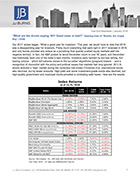“What the people need is a way to make them smile / It ain’t so hard to do if you know how” The Doobie Brothers, “Listen to the Music”
Many years ago, the Wall Street Journal ran its ‘Dartboard Contest.’ The idea was that staffers randomly throwing darts at stocks could pick better-performing stocks than professionals. Results were mixed and not firmly conclusive, but last’s year’s market results made the ‘dartboard portfolio’ seem like a great idea. Of the 17 indexes listed below, 11 did better than the very long-term return for U.S. stocks (about 10%). U.S. and international stocks shrugged off Q4-18’s bear market and a lot of policy uncertainty to rally for well-above-average returns. Equity and bond markets rallied on the Fed’s decisions to first pause—and then reverse—its rate-hike regime, despite civil unrest around the world and other policy uncertainties, particularly with global trade. With a nod to 2020 Rock and Roll Hall of Fame inductees The Doobie Brothers, here are the results:
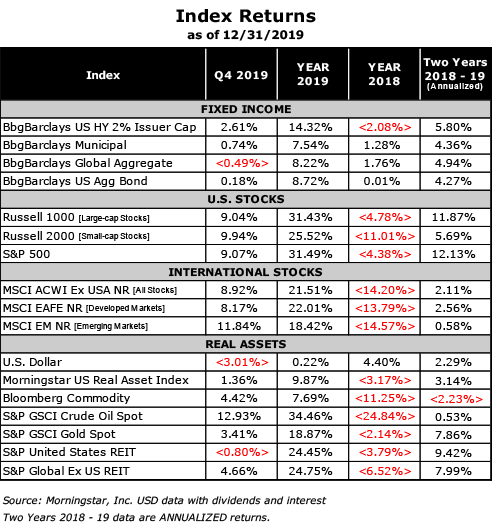
“It’s better to burn out / Than to fade away / My my, hey hey” Neil Young, solo inductee 1995, “My My, Hey Hey (Out of the Blue)”
We expected slower economic growth and positive, but muted, equity and bond returns in 2019. We were directionally right but underestimated the strength of market rebounds after the Q4-18 ‘flash bear.’ We continue to be happily surprised by the markets’ willingness to shrug off policy missteps that have no seemingly rational resolutions, but that amplifies our sense of cautious optimism. As we look at what might be ahead, let’s look first at the elephant in the room: a possible U.S. recession. This table reflects some key economic indicators and where are we with respect to past recessions:
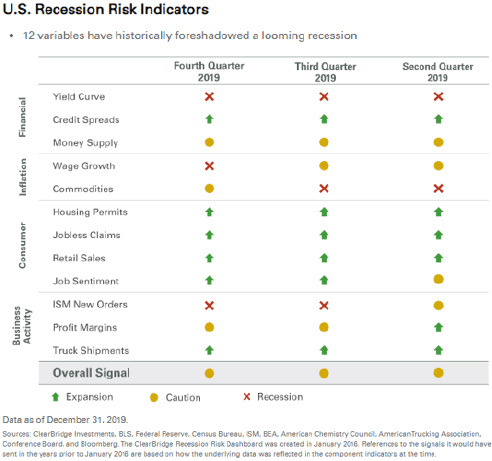
We can see that six of the twelve indicators here are still positive, and only three are negative. We might argue that the yield curve indicator has become positively sloped again (i.e. long-term yields are greater than short-term yields), and the inversion has a limited (i.e. few observations) history of predictability. Consumer measures remain positive, and measures of consumer sentiment are high.
We would also note that there was slowing in wage growth and ISM New Orders, and a declining trend in margins, which may influence stock earnings going forward. The new orders trend may be a byproduct of the global trade war. Phase 2 of the U.S. / China trade agreement, Brexit issues and implementation of the USMCA trade deal (the NAFTA replacement) may be having some effects on corporate planning and production.
The following table takes these same indicators and illustrates their levels through the past seven recessions. The current year-end readings are on the far left for comparison:
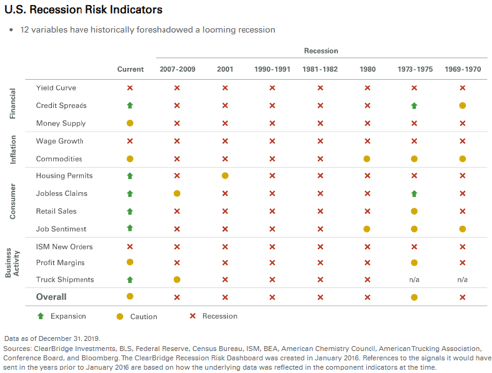
“Live right each day and smile on your way / And it don’t cost very much” Mahalia Jackson, inducted 1997, “It Don’t Cost Very Much”
This U.S. data, particularly the consumer readings, has promoted faith in a continuing economic expansion, but at lower rates than from just two years ago. These muted U.S. expectations have rolled globally as well, as this snapshot of regional growth and core inflation demonstrates:

Each of these regions is expected to have positive but low growth below the levels of 2018. That may not sound like the best news, but there are few signs of—or expectations for—recessions. A key contributor to this slower growth is demonstrated in the right-hand graph: persistently low inflation.
As we’ve previously discussed, some inflation is desirable for several reasons, including pricing power, wage growth and higher interest rates (which are important for pensions and savers). Of course, persistently high inflation is destabilizing, but we can also see that these range-bound numbers have resisted the massive post-Financial Crisis monetary stimulus from global central banks.
If we translate lower inflation expectations to still-accommodative monetary policy and continued growth, we also expect more tailwinds for access to capital markets. A key question that follows at this point in the cycle is, what are the markets pricing in, and what might cause bouts of heightened volatility? We would classify general sentiment as ‘cautiously optimistic,’ but believe that global trade uncertainty and fear of policy missteps will be potentially the biggest deterrents to markets this coming year. Here’s a summary of key expectations that are ‘priced in’ to markets:
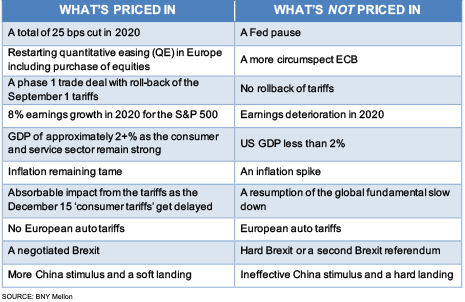
“So tell me now and I won’t ask again / Will you still love me tomorrow” The Shirelles, inducted 1996, “Will You Love Me Tomorrow”
Investors are naturally concerned about stock returns this year, due to recessions worries and the blowout year they experienced in 2019. The good news is that, historically, the S&P 500 has often followed good years (30% or greater rolling 1-year returns) with…another good year:
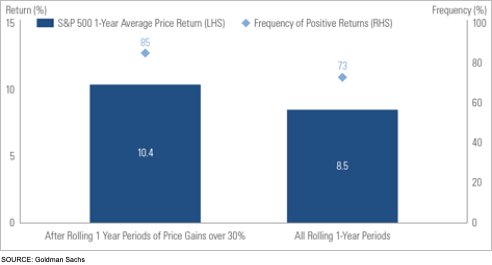
This data indicates that positive returns occurred in 85% of the post-30% return years, and returns were about 2% higher than all the rolling 1-year periods in the data.
We also frequently comment on the fact, and fervently believe, that earnings drive stock prices. While we share other observers’ concerns over higher valuations, margin pressure and trade-related growth issues, we see some robust earnings-growth estimates for the U.S. and Europe:
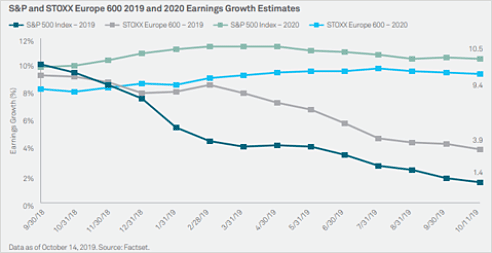
This data should be considered with the caveat that many of the risks to these estimates are to the downside, including the previously noted trade and other policy issues and an unforeseen shock, such as an inflation spike or a broader regional conflict involving the U.S. military. We should note that volatility fears (as measured by the VIX) appear to be currently contained, despite a rise in policy uncertainty. The authors of this graph accurately describe it as “few signals, plenty of noise”:
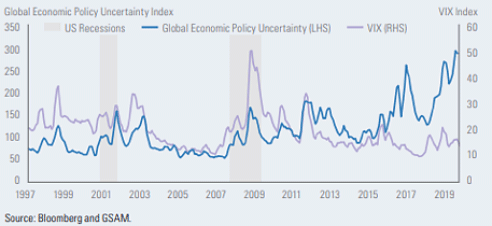
“And you may ask yourself, well / How did I get here?” Talking Heads, inducted 2002, “Once in a Lifetime”
One important backstop to the many estimations of growth and market returns is the (again) ‘easy money’ polices of central banks. Initial tightening regimes (i.e. higher rates and/or reduced asset purchases) were the order of the day until the ‘flash bear.’ Rather than ride into mini-recessions, many central bankers (CBs)—including the Fed—erred on the side of caution and either lowered policy rates, bought bonds or did both. The Fed has recently been providing liquidity to the overnight repo markets as an additional support strategy to its rate cuts last year. Some estimates indicate that global monetary policy is at its most ‘accommodative’ levels since the Global Financial Crisis (GFC):
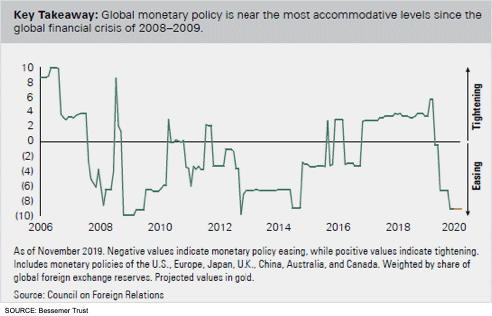
This re-emergence of looser central bank activity gives us some hesitation in our positive market reviews. Almost all the post-GFC stimulus has been monetary in nature; central bank balance sheets have mushroomed, and the continued efficacy of Central Bank actions and easy money is earning increasingly skeptical reviews. Fiscal policy—expenditures such as the proposed national infrastructure rebuild in the U.S.—have been scarce. Under the current administration, we have seen deficits soar without a corresponding ‘hard money’ spend. The increased Central Bank activity has also helped promote a growing global debt load (private and public), negative rates internationally, and the lack of ‘true’ pricing in capital markets:
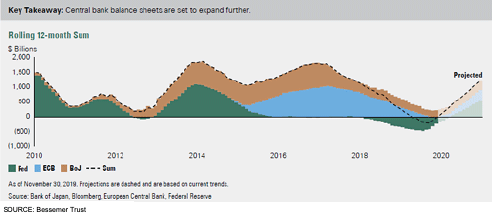
“They’ll stone ya when you’re tryin’ to make a buck / They’ll stone ya and then they’ll say, “good luck” / Tell ya what, I would not feel so all alone / Everybody must get stoned” Bob Dylan, inducted 1988, “Rainy Day Women #12 and 35”
This annual review is an opportune time to review our prior-year expectations. We thought stocks and bonds would rebound into positive territory from the 2018 ‘flash bear,’ the global economy would exhibit slow growth, and policy uncertainty would remain a key driver of markets and growth expectations. We don’t see much difference in this year’s review and current data to cause us to radically alter those expectations for 2020. We expect positive returns for most asset classes, but at lesser levels than 2019 and harder earned (i.e. more volatile). We also attribute much of the growth in portfolios in 2019 due to allocation positioning: broad exposure to global equities (across market cap and style), longer duration (interest-rate exposure), and a good blend of risk assets in equities and fixed income. Our expectations for 2020 results can be summarized as follows:
- Global growth by region will be positive but lower than recent trend.
- Equities will post solid but unspectacular returns; ex-U.S. stocks have favorable currency and valuation tailwinds.
- Bonds, barring a crisis, will trade in a range that approximates current yields.
- Global policy uncertainty will remain, with many regional flashpoints; more heated rhetoric and volatility should be expected as the U.S. fall elections near.
A key 2019 tailwind for investors was a strategic approach to asset allocation; put simply, it’s the ability to resist trying to time the market. Investors who stayed invested during the Q4-18 bear were well rewarded last year. We’ve found that holding to the discipline of setting appropriate asset allocations and periodic portfolio rebalancing as markets correct keeps our clients on track with their long-term goals. This important behavioral control is frequently measured and written about, but a new review of the near-impossible task of successful market-timing is shown below:
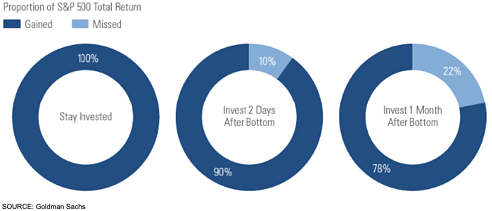
Briefly, this data demonstrates cumulative returns earned five years after market troughs in October 1990, October 2002 and March 2009. The average five-year cumulative return was 147%; clearly, missing two days or one month of rebound returns can be costly. Note that these returns are based on market bottoms, when investor sentiment is at its most negative. Clearly a strategic approach that avoids tactical timing proves more advantageous for the majority of equity investors.
Our job is to ensure that our clients meet their long-term goals. We know that these may periodically change, so please be sure to contact us to discuss your plan and portfolio(s) so we can keep you on track.
As always, we welcome your comments, questions and feedback. We wish you and your families a healthy, happy and prosperous new year.
—Your Wealth Management Team at JJ Burns & Company
Download Market Commentary
Disclosure: J.J. Burns & Company, LLC is a registered investment adviser with the U.S. Securities & Exchange Commission and maintains notice filings with the States of New York, Florida Pennsylvania, New Jersey, Connecticut, Georgia, Illinois, North Carolina, and California. J.J. Burns & Company, LLC only transacts business in states where it is properly registered, or excluded or exempted from registration. Follow-up and individualized responses to persons that involves either the effecting or attempting to effect transactions in securities, or the rendering of personalized investment advice for compensation, as the case may be, will not be made absent compliance with state investment adviser and investment adviser representative registration requirements, or an applicable exemption or exclusion.
All investing involves risk, including the potential for loss of principal. There is no guarantee that any investment plan or strategy will be successful.
The foregoing content reflects the opinions of J.J. Burns & Company, LLC and is subject to change at any time without notice. Content provided herein is for informational purposes only and should not be used or construed as investment advice or a recommendation regarding the purchase or sale of any security. There is no guarantee that the statements, opinions or forecasts provided herein will prove to be correct.
Past performance may not be indicative of future results. Indices are not available for direct investment. Any investor who attempts to mimic the performance of an index would incur fees and expenses which would reduce returns.
Securities investing involves risk, including the potential for loss of principal. There is no assurance that any investment plan or strategy will be successful.


